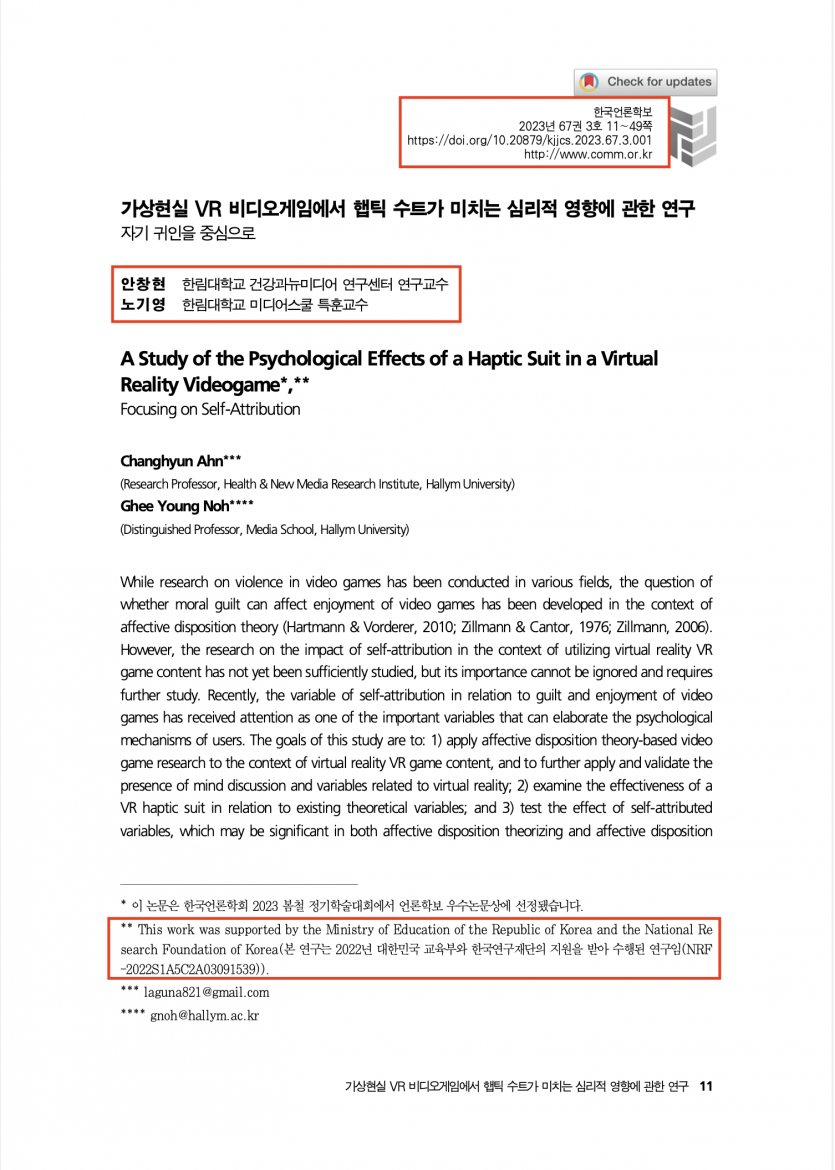가상현실 VR 비디오게임에서 햅틱 수트가 미치는 심리적 영향에 관한 연구 : 자기 귀인을 중심으로
페이지 정보
- 최고관리자
- 24-04-08
- 1,688 views
- 2023
본문
비디오게임의 폭력성에 관한 연구는 다방면으로 진행됐으나, 특히 비디오게임을 체험할 때 ‘도덕적 죄책감이 즐거움에 영향을 미칠 수 있는가’에 관해서는 정서적 성향이론을 중심으로 연구가 발전되었다(Hartmann & Vorderer, 2010; Zillmann, 2006; Zillmann & Cantor, 1976). 최근 비디오게임의 죄책감 및 즐거움과 관련하여 자기 귀인이라는 변인은 특히 커뮤니케이션 분야의 비디오게임 연구에서 이용자들의 심리학적 메커니즘을 정교하게 밝힐 수 있는 중요한 변인 중 하나로 주목받고 있으나, 특히 ‘자기 귀인’과 관련하여 가상현실 VR 게임 콘텐츠를 활용한 상황에서의 효과 연구는 아직 충분한 연구 결과가 나오지 않았지만, 그 중요성은 무시할 수 없으며 더 많은 학문적 주목과 연구 자원이 필요한 상황이다. 본 연구는 가상현실 VR 비디오게임에서 햅틱 수트가 미치는 효과를 독립변인으로 설정하여 가상현실 VR게임 이용자들의 심리적 경험에 어떻게 영향을 미치는지를 검증하고자 하였다. 연구 결과 햅틱 수트의 착용 여부는 현존감에 유의미한 정적 효과를 주었으나 자기 귀인에는 유의미한 효과를 주지 못해, 기존의 현존감 논의 및 고무손 착시효과(Rubber hand illusion) 논의와 일치하는 결과를 보여주었다. 또한 햅틱수트의 착용이 현존감을 거쳐 즐거움에 영향을 주는 간접효과를 발견하였다.
While research on violence in video games has been conducted in various fields, the question of whether moral guilt can affect enjoyment of video games has been developed in the context of affective disposition theory (Hartmann & Vorderer, 2010; Zillmann & Cantor, 1976; Zillmann, 2006). However, the research on the impact of self-attribution in the context of utilizing virtual reality VR game content has not yet been sufficiently studied, but its importance cannot be ignored and requires further study. Recently, the variable of self-attribution in relation to guilt and enjoyment of video games has received attention as one of the important variables that can elaborate the psychological mechanisms of users. The goals of this study are to: 1) apply affective disposition theory-based video game research to the context of virtual reality VR game content, and to further apply and validate the presence of mind discussion and variables related to virtual reality; 2) examine the effectiveness of a VR haptic suit in relation to existing theoretical variables; and 3) test the effect of self-attributed variables, which may be significant in both affective disposition theorizing and affective disposition theory. In particular, this study aimed to test the effect of the VR haptic suit as an independent variable and how it affects the psychological experience of VR game users. The results of the study are summarized as follows. First, this study found that the effects of wearing the haptic suit on presence and self-attribution were consistent with existing research on presence and the rubber hand illusion. Specifically, we can posit that the haptic suit"s vibration is a reaction to proprioceptive information that is sent to the arms, torso, and other body parts, and is thus unrelated to self-attribution, which is more associated with optical illusions (Botvinick & Cohen, 1998; Haans, & IJsselsteijn, 2007). Second, this study found that the presence of the suit itself had an indirect effect on presence, which in turn affected enjoyment. The following highlights the importance of this study. First, this study combined and expanded on the issue of presence by applying the emotionally based theory of video games to the setting of virtual reality VR games. For instance, the two-dimensional screens used as video game stimuli in earlier studies (Grizzard et al., 2014; Weaver & Lewis, 2012; Holl et al., 2020) had little theoretical possibilities for combining the concepts of presence and self-attribution. Second, the impact of the haptic suit on presence in a virtual reality VR game was empirically confirmed by this study. As a continuation of theoretical discussions about the sense of embodiment, it is apparent that haptic suits can be a significant experimental tool to evaluate both presence and self-attribution.
Citation
안창현, 노기영. (2023). 가상현실 VR 비디오게임에서 햅틱 수트가 미치는 심리적 영향에 관한 연구 : 자기 귀인을 중심으로. 한국언론학보, 67(3), 11-49, 10.20879/kjjcs.2023.67.3.001
